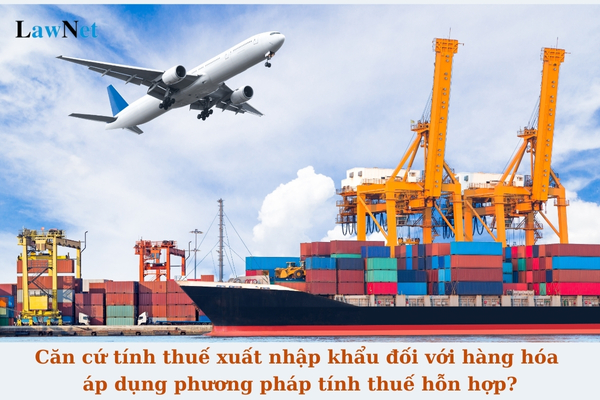What is the tax basis for imports and exports applying the mixed tax method in Vietnam?
What is the tax basis for imports and exports applying the mixed tax method in Vietnam?
Pursuant to Clause 1, Article 38 of Circular 38/2015/TT-BTC, the tax basis for imports and exports applying the mixed tax method is stipulated as follows:
Basis and Method of Tax Calculation for Goods Applying Absolute Tax, Mixed Tax
- Tax Calculation Basis:
a) The tax calculation basis for goods applying absolute tax is:
a.1) The actual export or import quantity of each item recorded in the customs declaration applying absolute tax;
a.2) The absolute tax rate specified per unit of goods;
a.3) The exchange rate for tax calculation.
b) The tax calculation basis for goods applying mixed tax is:
b.1) The actual export or import quantity of each item recorded in the customs declaration applying mixed tax;
b.2) The percentage tax rate and the taxable value of goods applying mixed tax as stipulated in point b, point c of Clause 1, Article 37 of this Circular;
b.3) The absolute tax level of goods applying mixed tax as stipulated in point a, Clause 1 of this Article;
b.4) The exchange rate for tax calculation.
...
According to the above regulations, the tax basis for imports and exports applying the mixed tax method includes:
- The actual export or import quantity of each item recorded in the customs declaration applying mixed tax;
- The percentage tax rate and the taxable value of goods applying mixed tax as stipulated in point b, point c of Clause 1, Article 37 of Circular 38/2015/TT-BTC;
- The absolute tax level of goods applying mixed tax;
- The exchange rate for tax calculation.

What is the tax basis for imports and exports applying the mixed tax method in Vietnam? (Image from Internet)
What is the tax calculation method for imports and exports applying mixed tax in Vietnam?
According to the provisions at point b, Clause 2, Article 38 of Circular 38/2015/TT-BTC, the method for calculating the tax for imports and exports applying mixed tax is as follows:
The payable export tax and import tax for goods applying mixed tax = Tax amount calculated according to the provisions in Clause 2, Article 37 of Circular 38/2015/TT-BTC + Payable absolute tax amount
Where:
- Tax amount calculated according to the provisions in Clause 2, Article 37 of Circular 38/2015/TT-BTC = Actual export or import quantity of each item recorded in the customs declaration x Taxable value per unit of goods x Tax rate of each item
- Payable absolute tax amount = Actual export or import quantity of each item recorded in the customs declaration applying absolute tax x Absolute tax rate specified per unit of goods x Exchange rate for tax calculation
What entities are subject to import and export duties in Vietnam?
According to Article 2 of the Law on Export and Import duties 2016, the subjects to tax are defined as follows:
- Goods exported and imported through Vietnam's borders and customs checkpoints.
- Goods exported from the domestic market into a non-tariff zone, goods imported from a non-tariff zone into the domestic market.
- Goods exported or imported on the spot and goods exported and imported by enterprises exercising export, import, and distribution rights.
- Export and import duties do not apply to the following cases:
+ Goods in transit, transshipment, or transfer;
+ Humanitarian aid goods, non-refundable aid goods;
+ Goods exported from a non-tariff zone abroad; goods imported from abroad into a non-tariff zone and only used within the non-tariff zone; goods transferred from one non-tariff zone to another;
+ Petroleum used to pay the state’s resource tax when exporting.
What is the current deadline for paying import and export duties in Vietnam?
According to the provisions of Article 9 of the Law on Export and Import duties 2016, the deadline for paying import and export duties is:
- Goods subject to tax must pay the tax before clearance or release according to the Customs Law, except in the case stipulated in Clause 2, Article 9 of the Law on Export and Import duties 2016.
- If a credit institution guarantees the tax amount, the goods may be cleared or released but the late payment fee must be paid according to the Tax Management Law, calculated from the day of clearance or release until the tax is paid. The maximum guarantee period is 30 days from the date of customs declaration registration.
- If the tax guaranteed period ends and the taxpayer has not yet paid the tax and late payment fee, the guarantor is responsible for paying the full tax and late payment fee on behalf of the taxpayer.
- Taxpayers enjoying preferential policies under the Customs Law may delay paying duties for customs declarations until the tenth day of the following month. After this deadline, if the taxpayer has not paid the duties, the overdue tax amount and late payment fee must be paid according to the Tax Management Law.

